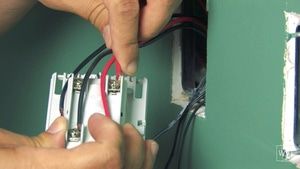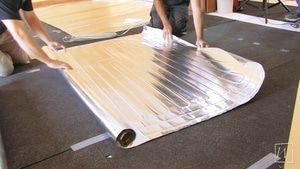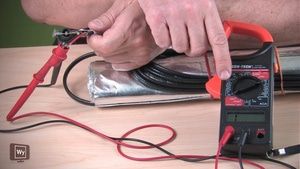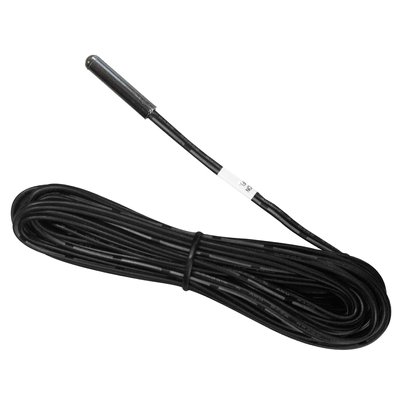
Environ 120V 5ft x 15ft panel - Round Cold Lead
This support page provides publications, manuals, specifications, videos, support articles, and common support questions
Common Support Questions
No. Never cut the heating cable. The floor heating cable is designed with a very specific resistance in order to consistently maintain heating at a specific wattage per square foot. Trimming the heating cable lowers the resistance of the cable causing the system to overheat. WarmlyYours recommends obtaining a complimentary SmartPlan™ Floor Heating Installation Plan to assure a good installation.
Need more help? View support options
Yes. Unlike the heating cable for electric floor heating, the cold lead wires can be trimmed.
Need more help? View support options
When installing electric floor heating over a concrete slab, an insulating underlayment like ThermalSheet is highly recommended to ensure efficient operation, faster heating times and warmer floor temperatures.
Need more help? View support options
To prevent any melting, ensure that the heating wire is at least 4” from the toilet wax ring.
Need more help? View support options
Yes, but any furniture that may trap heat, such as pieces with an enclosed bottom, should be avoided. Furniture on legs with a clearance of at least 3" is permissible.
Need more help? View support options
When WarmlyYours electric floor heating systems are being installed on a concrete slab, we strongly recommend adding a layer of insulation over the slab prior to installing the system. While our electric floor heating provides up to 25% more heating power per square foot than many of our competitors, the slab will always act as a "heat sink." Some of the heat that would otherwise be transferred to the flooring surface will remain in the slab, causing the floor’s surface temperature to be considerably lower. This is true with any electric radiant floor heating system.
When installed on top of a concrete slab without insulation, it is generally accepted that electric floor heating will take the chill away from the floor and provide a small amount of warmth. Adding insulation on top of the slab and beneath any electric radiant floor heating system will allow a greater percentage of the heat generated to transfer to the flooring surface. This results in greater efficiency and therefore faster warm up times, higher expected surface temperatures and lower energy usage. The floor will have the capacity to warm to a comfortable temperature, and in some cases can be employed as the primary heat source for that room.
The recommended types of insulation are natural cork, insulated tile backer boards and insulated underlayment, such as ThermalSheet™ synthetic cork.
Need more help? View support options
Electric-resistance heating cables and systems have no polarity. This includes all current WarmlyYours heating elements.
Need more help? View support options
The breaker and wire sizes are selected based on the total amperage of the WarmlyYours heating system connected to a single thermostat. This information is on the WarmlyYours heating system's installation plan, electrical plan, or UL label. Based on guidelines from the National Electrical Code: loads up to 16 Amps may utilize 12 gauge wire with a 20-Amp breaker, and loads up to 12 Amps - 14 gauge wire with a 15-Amp breaker. Local code and/or other factors may change these guidelines.
Need more help? View support options
One thermostat can control multiple heating mats/cables as long as all the heating elements are using less than 15 amps:
TempZone™ will cover aprx. 120 sq. ft. for 120V systems and 240 sq. ft. for 240V systems on one thermostat.
Environ™ will cover aprx. 150 sq. ft. for 120V systems and 300 sq. ft. for 240V systems on one thermostat.
Slab Heat will cover aprx. 90 sq. ft. for 120V systems and 180 sq. ft. for 240V systems on one thermostat.
Need more help? View support options
Make sure any cracks or raised edges are sanded down before installation. Seal and patch cracks where possible. If needed, pour a layer of self-leveling cement to make sure surface is level and flat. Then proceed with instructions to install desired floor heating system and flooring.
It is strongly recommended that an insulating underlayment be installed between the slab and heating element to prevent heat loss.
Need more help? View support options
WarmlyYours has recently begun including floor sensors with our heating elements to help ensure customers will have everything they need for optimal operation of their radiant heating systems.
The sensor included with your floor heating element can be installed with the heating system (the sensor is equally spaced between runs of the heating wire--see your install manual for more info). Installing this sensor with your floor heating control will enable energy efficient operation of the floor warming system based on the floor temperature instead of the ambient room temperature.
We generally recommend that you install a second, unconnected backup floor sensor alongside the primary one. In the very unlikely event that your first floor sensor is damaged, this install method will save you from having to pry up flooring to replace a floor sensor. You simply disconnect the damaged sensor from the thermostat and connect the backup sensor.
In addition to the floor sensor that was included with your heating element, our nSpiration Series thermostats also come with a floor sensor. If you purchase both a heating element and an nSpiration Series thermostat from WarmlyYours, you'll have a primary and a backup floor sensor for your system.
Need more help? View support options
Check the flooring r-value before installing. As long as the flooring product has an r-value of 1 or less, it should work well with electric floor heating. Underlayment must be placed on the subfloor and be placed under the heating layer. For ease of installation, we strongly recommend the underlayment be at least 1/4" thick, and the heating element should be placed between the underlayment and the flooring. Do not place any underlayment between the element and the flooring.
Need more help? View support options
Multiple Environ™ products may be connected in parallel directly to a thermostat or through the junction box. Please ensure the total amperage of all connected mats doesn’t exceed the thermostat’s maximum load.
Need more help? View support options
82°F - 85°F is the most common comfortable warm temperature of the floor.
Need more help? View support options
Installing Environ™ under wood laminate flooring requires a suitable underlayment beneath the heating elements. Never install Environ™ between two hard surfaces. Underlayments that are less than 2mm in thickness and that are not Robinson-rated are not acceptable. Underlayment is necessary to prevent Environ™ Flex Rolls from damage due to the weight of the floor, furniture, and people. Unavoidable wooden floor movements will not harm Environ™.
Installing Environ™ under carpeting(USA only) requires a suitable cushion/pad beneath the heating elements. Never install Environ™ between two hard surfaces. Carpet padding must have a density of at least 6 pounds per cubic foot, the higher the R-Value the better. 1/2“ Prime Urethane (R-2.15) and 1/2“ Bonded Urethane(R-2.1) are good choices. Adhere to Restrictions on Furniture Placement outlined on page 12 of Environ Install manual when installing under carpeting.
Environ™ must not be installed in direct contact with concrete, it is mandatory when installing over concrete to use a 1/4“ (6mm) Robinson-rated underlayment.
Certain underlayments, such as 1/4” (6mm) thick cork, or 6mm ThermalSheet are recommended for Environ™. It is also acceptable to place a vapor barrier, such as a plastic sheet, beneath the underlayment. Underlayment paper is not an acceptable underlayment choice.
Always check with the manufacturer of the flooring, carpeting, and underlayment for limitations and compatibility with electric radiant heating. Adhere to national and local code regarding electric radiant heating systems.
Need more help? View support options
Most laminate flooring manufactured today are made of wood flour and resin composites. However, there are still some manufacturers making laminates primarily of real wood. This is important because a primarily wood laminate can be floated over the Environ™ floor heating product. Otherwise, if it is not made primarily of wood, the flooring will require the TempZone™ floor heating product embedded in thin-set or self-leveling cement.
Check the laminate manufacturer's material composition, the specific product warranty for radiant or electric heat exclusions, and the installation documentation for compatibility. A clue that it's not a wood laminate is if 1/2“ separation is required between the heaters and the laminate.
Need more help? View support options
A digital meter with a 0-200 Ohms scale ( Ω ) to measure the heating wire's resistance, and a 20K scale to measure the sensor's resistance.
Need more help? View support options
For Tempzone it is 51 BTU’s per square foot per hour and for Environ, it is 41. Take the wattage of the product (shown on the product’s label) and multiply that by 3.41. That is the BTU value for that product.
Need more help? View support options
No. Most vinyl flooring requires a solid flat surface to maintain its shape and many recommend that their flooring is kept at least ½“ away from the heating element. The best solution for vinyl floor covering is our TempZone™ floor heating cable or mats embedded in self leveling cement. Always check with the flooring product's manufacturer regarding limitations, warranties, and installation requirements.
Need more help? View support options
For under carpet installation, certain restrictions on furniture placement apply. Please refer to the installation guide for further details.
Need more help? View support options
Single Conductor vs. Twin Conductor Identification
- A single conductor floor heating system is a loop of one core wire, it starts at the thermostat and ends at the thermostat - this is the original method of manufacturing heating cable. Most single conductor floor heating systems have the same color cold lead wire connected to both load terminals/pigtails of the thermostat. Some early single conductor floor heating systems were produced with a white and a yellow cold lead wire.
- A twin conductor floor heating system terminates two core wires at the end, both wires start at the thermostat - this is the current method of manufacturing heating cable. Most twin conductor floor heating systems will have two different colored cold lead wires, and one of these is black. The other wire in a WarmlyYours floor heating system is either yellow (120V system) or red (240V system). A few early Environ systems had two black cold lead wires.
Note:
- Not all heating cables are wired directly to the thermostat. It may have been necessary during installation to terminate the heating cable in a junction box, and then run a separate (contractor-supplied) wire from the junction box to the thermostat.
- WarmlyYours single conductor cold leads were produced with a 13‘ length at the start of the loop, and a 26‘ length at the end. The 120V floor heating systems had a yellow and a white label attached to the cold leads, and the 240V floor heating systems had a red and a white label attached.
- If you have a single conductor floor heating system and notice that one cold lead is thicker or feels hotter than the other, please contact technical support at +1 (800) 875-5285
Need more help? View support options
Test the Environ floor heating element using a digital ohm meter.
Here is a guide and here is a video showing how to do this test.
Need more help? View support options
The Environ™ Flex Rolls and Easy Mats are designed to deliver 12 watts per square foot.
Need more help? View support options
Most Laminates with an attached cork, foam, or rubber backing are not good Environ™ heated flooring candidates. There are exceptions of course, check the manufacturer's warranty information and compatibility of the flooring product with electrically heated floors. If the laminate has a pre-attached pad, verify that the laminate has an R-Value of 1 or less.
Need more help? View support options
The amount of amperage draw depends upon how large the area is that you are heating. For coverage of areas less than 30 square feet, a 120V Environ system will draw less than 3 amps. If you have a larger area over 300 square feet of heated space, then you will need a larger breaker plus additional controls. No matter what the size of the area you choose to heat, we recommend a dedicated circuit for your electric radiant floor heating system.
Need more help? View support options
The ground wire in the floor mat must be connected directly to the ground wire of the supply or to the house ground wire.
Need more help? View support options
Publications and Manuals
General Publications
Design Floor Plan Grid Wayfair (English)Floor Heating Products by Flooring Type and Subfloor (English)
Project Planners
Floor Heating Request for Quotation Form (English)Calculating Project Dimensions (English)
Environ Checklist Materials And Tools Checklist (English)
Technical Support
Environ™ Ohm Reading Guide (English)Cross Section Environ™ Mat under Carpet over Concrete (English)
Cross Section Environ™ Mat under Carpet over Plywood Subfloor (English)
Cross Section Environ™ Mat under Floating Laminate or Engineered Wood over Concrete (English)
Cross Section Environ™ Mat under Floating Laminate or Engineered Wood over Insulated Concrete (English)
Cross Section Environ™ Mat under Floating Laminate or Engineered Wood over Plywood Subfloor (English)
Environ™ Ohm Reading Guide (French)
Environ™ Ohm Reading Guide (Spanish)
Specifications
Electrical
| Amps | 6.9 A |
| Floor Load | 0.83 kW |
| Ohms | 17.39 |
| Thermal Power | 0.83 kW |
| Voltage | 120 V |
| Watts | 828 W |
| Watts Per Sq. Ft. | 12 Watts Per Sq. Ft. |
Warranty / Certifications
| Approvals | cULus listed |
| Warranty | 10 Year Warranty under Laminate & Floating Hardwood, 5 Year under Carpet (US Only) |
Performance
| BTU Per Hour | 2825 Btu |
Product Dimensions
| Cold Lead Length | 30′ |
| Coverage | 75 ft² |
| Heating Element Thickness | 1/16″ |
| Length | 15′ |
| Size | 5′ x 15′ |
| Width | 5′ |
Appearance
| Color | Silver |
Logistics
| Country of Origin (COO) | South Africa |
Installation
| Floor Types | Commonly installed beneath carpet (US Only) and laminate |
Identifiers
| SKU | 515-10-120 |
| UPC (GTIN-12) | 881308010522 |
Videos
Product Line Videos


Environ Floor Heating Installation under Floating Wood Laminate

How to Test an Environ Flex Electric Floor Heating Roll

Tech Tips: Wiring Environ to a Thermostat

Environ Easy Mats Featured On 'Kelsey On The House'

Introduction to Environ Easy Mats

Winterize Any Bedroom with Heated Laminate Floors

Carpet Seaming and Stretching on top of Radiant Floor Heating

Why and How to Install Floor Heating Under Laminate

Tech Tips: Environ Floor Heating Sensor Placement
Articles
Carpet Cleaning Over EVII Mats and EVII Flex Rolls
Customer complaint of Smell/Off-gassing from Environ Easy Mats
EVII Over a slab and under a carpet suggestions
How to Test Environ Products for Ohms, ohm testing
Similar Items
Do you need support or specifications for a specific model? Identify your model below.






